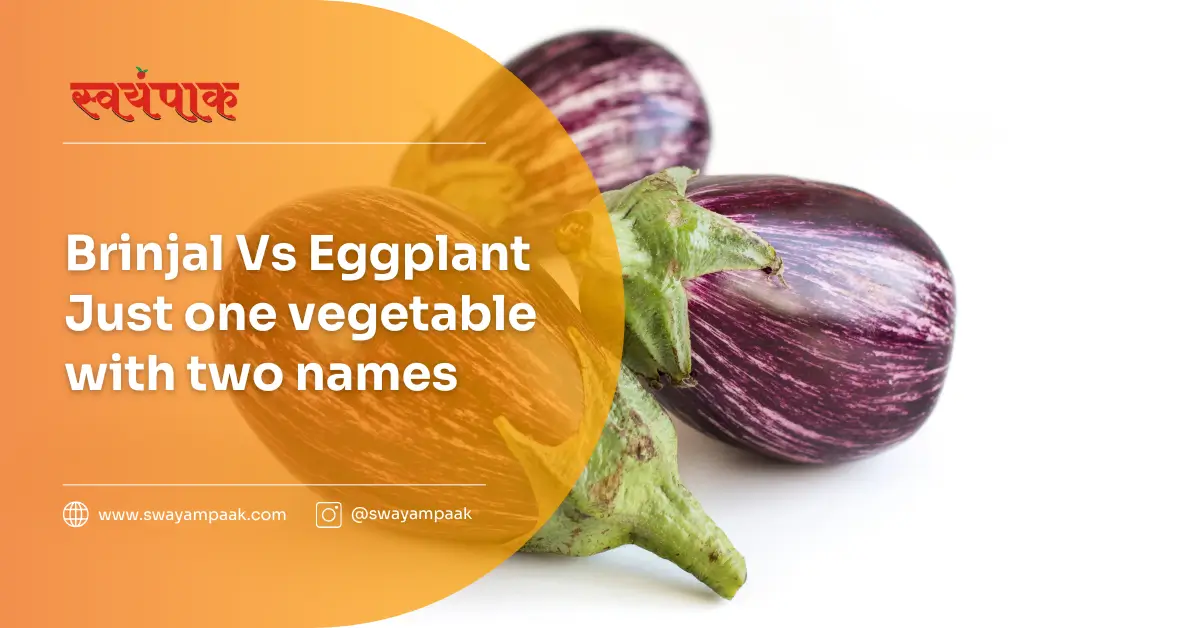Did you know that different names can call the same vegetable depending on where you are? Imagine slicing into a glossy, deep purple vegetable to make a creamy baba ghanoush or a sizzling eggplant parmesan. This versatile vegetable is known as “brinjal” in some parts of the world and “eggplant” in others, leading to confusion.
In this article Brinjal vs Eggplant, we’ll uncover the surprising truth behind these seemingly different vegetables and celebrate their global culinary presence.
10 Key Takeaways on Brinjal vs Eggplant
- Same Vegetable, Different Names: Brinjal and eggplant are simply two names for the same delicious nightshade vegetable.
- Brinjal in South Asia: The term “brinjal” is commonly used in South Asia, with roots traced back to the Portuguese word “berinjela.”
- Eggplant’s Historical Name: “Eggplant” refers to the early white, egg-shaped varieties of the vegetable.
- Solanum Melongena: The Scientific Name: Brinjal and eggplant are both classified as Solanum melongena, related to tomatoes, potatoes, and peppers.
- A World of Eggplant Delights: Eggplants (or brinjals!) come in various shapes, sizes, and colours, from classic pear-shaped to slender and even striped varieties.
- Brinjal/Eggplant: A Nutritional Powerhouse: Low in calories and high in fibre, brinjal/eggplant boasts vitamins B1, B6, K, potassium, manganese, and the antioxidant nasunin.
- Global Tapestry of Names: Beyond brinjal and eggplant, the vegetable has fascinating aliases worldwide – aubergine (France/UK), melanzana (Italy), baingan (India), and more!
- From Misunderstood to Culinary Gem: Ancient beliefs associated eggplant with madness and illness, but thankfully, these misconceptions faded.
- A Versatile Global Favorite: No matter the name, brinjal/eggplant is a globally adored ingredient for its ability to absorb flavours and creamy texture.
- Embrace the Culinary Journey: Explore new recipes and enjoy the diverse culinary adventures offered by brinjal/eggplant!
Brinjal vs Eggplant: Around the World
Ever wondered why that delicious purple veggie has two names? Fear not, fellow food adventurer, for we’re about to crack the case of brinjal vs eggplant!
Brinjal: A South Asian Star
While “eggplant” reigns supreme in Europe and North America, South Asia embraces a different term – brinjal. This word traces its roots back to the Portuguese “berinjela,” a testament to the global journey of this tasty nightshade.
Eggplant: A Name with History
But where does “eggplant” come from? Take a peek back in time! Early eggplant varieties were much smaller, sporting a white, egg-like appearance. Thus, the fitting (if slightly misleading) name stuck.
Solanum Melongena: The Truth Revealed
Despite their name difference, brinjal and eggplant are one and the same! Scientifically classified as Solanum melongena, this versatile veggie is a close relative of tomatoes, potatoes, and bell peppers.
A World of Eggplant Delights
Eggplants (or brinjals!) come in a dazzling array of shapes and sizes. From the classic pear-shaped globe eggplant to the slender Japanese variety, the options are endless. colours, too, explode with vibrancy, ranging from the familiar deep purple to surprising whites, greens, and even stripes.
Health Benefits
- Low in Calories: Helps in weight management.
- Rich in Antioxidants: Contains nasunin, a potent antioxidant in the skin that helps protect cells from damage.
- High in Fibre: Supports digestive health and helps maintain steady blood sugar levels.
- Good for Heart Health: Contains potassium, fibre, and vitamins that support cardiovascular health.
- Potential Blood Sugar Control: Low in carbohydrates and high in fibre, which can help manage blood sugar levels.
Nutritional Profile of Eggplant/Brinjal (per 100 grams)
- Calories: 25 kcal
- Carbohydrates: 5.88 g
- Protein: 1 g
- Fat: 0.18 g
- Fiber: 3 g
- Sugars: 3.53 g
- Vitamin C: 2.2 mg (4% of Daily Value, DV)
- Vitamin K: 3.5 µg (4% DV)
- Vitamin B6: 0.084 mg (6% DV)
- Folate: 22 µg (5% DV)
- Potassium: 229 mg (7% DV)
- Manganese: 0.232 mg (10% DV)
- Magnesium: 14 mg (4% DV)
- Iron: 0.24 mg (1% DV)
A World of Names for the Humble Eggplant (Brinjal)
Brinjal and eggplant may be the most common names for this versatile vegetable, but its journey across continents has gifted it with a fascinating collection of aliases. Let’s embark on a linguistic adventure to explore some of the most intriguing!
Aubergine: A French Fancy
Across the English Channel, our beloved eggplant transforms into “aubergine” in France and the United Kingdom. This term likely originated from the Arabic “al-badhinjan,” which itself evolved from the Persian “badingan.” The “al” prefix, meaning “the,” got dropped along the way, resulting in the modern aubergine.
Melanzana: The Italian Music of the Eggplant
Italy takes a more melodious approach with “melanzana.” This name finds its roots in the Latin “mala insana,” which translates to “mad apple.” While the reason behind this curious moniker remains unclear, some speculate it might be due to the eggplant’s association with the nightshade family, known for its sometimes toxic members. Thankfully, the cultivated eggplant is perfectly safe to enjoy!
Baingan: A Spicy Name from India
Back in South Asia, where brinjal reigns supreme, another interesting name emerges – “baingan.” This term is used widely in India and neighbouring countries. While the exact etymology is debated, some believe it might be derived from the Sanskrit word “vatingana,” which translates to “wind dispelled.” Perhaps this name reflects the traditional belief in eggplant’s ability to aid digestion.
Beyond Borders: A Global Tapestry of Names
The list doesn’t end there! In China, eggplant is known as “qiezi,” meaning “eggplant” quite literally. Japan uses “nasu,” a name with a delightful onomatopoeic quality. And in Greece, they call it “melitzanos,” which translates to “black apple.” Each name adds a unique thread to the rich tapestry woven by this globally adored vegetable.
So, the next time you encounter eggplant, brinjal, aubergine, melanzana, baingan, or any other of its delightful aliases, remember – you’re not just enjoying a delicious ingredient, but also savouring a piece of linguistic history that has travelled the world.
A History of Misunderstood Majesty
Eggplant, or brinjal as it’s known in South Asia, boasts a history as colourful as its many varieties. Believe it or not, this versatile veggie wasn’t always celebrated for its culinary delights. In fact, ancient civilizations held some rather bizarre beliefs about eggplants! They were thought to induce madness, leprosy, and even cancer. Thankfully, these misconceptions faded over time, allowing eggplants to take their rightful place on our plates.
The name “eggplant” itself offers a glimpse into the vegetable’s past. Early varieties were much smaller and sported a white, egg-like appearance. This resemblance, though not entirely accurate with today’s vibrant eggplants, stuck around, giving us the name we know today.
Conclusion
The brinjal and the eggplant may seem like different vegetables, but this article has revealed the surprising truth – they’re one and the same! This versatile nightshade relative boasts a fascinating history and a delightful array of names around the world.
We explored the origins of “brinjal” in South Asia, tracing its roots back to the Portuguese “berinjela.” We learned how “eggplant” came about, referencing the early white, egg-shaped varieties. Despite the name difference, brinjal and eggplant are scientifically classified as Solanum melongena, offering a delicious range of shapes, sizes, and colours.
This beloved vegetable isn’t just a culinary delight; it’s packed with health benefits. Low in calories and high in fibre, brinjal/eggplant keeps you feeling fuller for longer. It’s a treasure trove of vitamins and minerals, while the antioxidant nasunin protects your cells.
Beyond brinjal and eggplant, we embarked on a linguistic adventure, discovering a world of intriguing aliases. From the French “aubergine” and the Italian “melanzana” to the Indian “baingan” and the Greek “melitzanos,” each name adds a unique thread to the tapestry of this globally adored vegetable.
The history of the eggplant/brinjal is just as interesting as its names. While once thought to cause madness, leprosy, and cancer, these misconceptions have faded, allowing us to fully appreciate this culinary gem.
In conclusion, brinjal and eggplant are simply different names for the same amazing vegetable. No matter what you call it, this versatile ingredient is a global favourite, celebrated for its ability to absorb flavours and its rich, creamy texture.
So, embrace the brinjal in South Asia, the eggplant in North America, or any of its delightful aliases around the world. Explore new recipes, experiment with different flavours, and enjoy the culinary journey that eggplant/brinjal has to offer!


